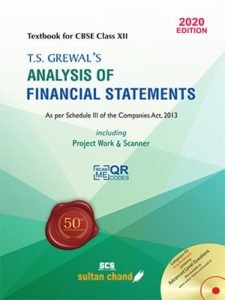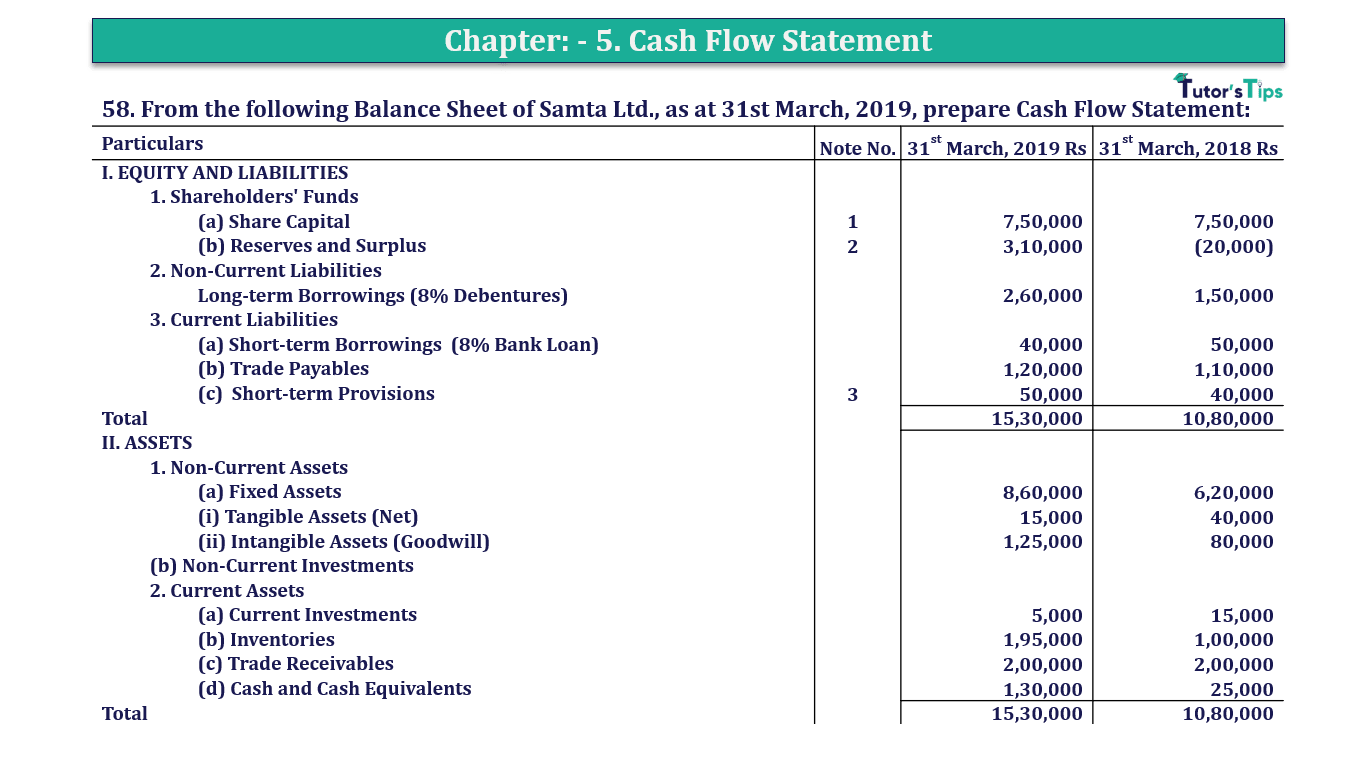Question 43 Chapter 5 of +2-B
Table of Contents
43. Following are the Balance Sheets of Solar Power Ltd. as at 31st March, 2014 and 2013:
| BALANCE SHEET of Solar Power Ltd. | |||
| Particulars | Note No. | 31st March 2014 Rs | 31st March 2013 Rs |
| I. EQUITY AND LIABILITIES | |||
| 1. Shareholders’ Funds | |||
| (a) Share Capital | 24,00,000 | 22,00,000 | |
| (b) Reserves and Surplus | 1 | 6,00,000 | 4,00,000 |
| 2. Non-Current Liabilities | |||
| Long-term Borrowings | 4,80,000 | 3,40,000 | |
| 3. Current Liabilities | |||
| (a) Trade Payables | 3,58,000 | 4,08,000 | |
| (b) Short-term Provisions | 1,00,000 | 1,54,000 | |
| Total | 39,38,000 | 35,02,000 | |
| II. ASSETS | |||
| 1. Non-Current Assets | |||
| Fixed Assets : | |||
| (i)Tangible Assets | 2 | 21,40,000 | 17,00,000 |
| (ii) Intangible Assets | 3 | 80,000 | 2,24,000 |
| 2. Current Assets | |||
| (a) Current Investments | 4,80,000 | 3,00,000 | |
| (b) Inventories | 2,58,000 | 2,42,000 | |
| (c) Trade Receivables | 3,40,000 | 2,86,000 | |
| (d) Cash and Cash Equivalents | 6,40,000 | 7,50,000 | |
| Total | 39,38,000 | 35,02,000 | |
Notes to Accounts
| Particulars | 31st March, | 31st March, 2013 (Rs) |
| 2014 (Rs) | ||
| 1. Reserves and Surplus | ||
| Surplus, i.e., Balance in Statement of Profit and Loss | 6,00,000 | 4,00,000 |
| 2. Tangible Assets | ||
| Machinery | 25,40,000 | 20,00,000 |
| Less: Accumulated Depreciation | 4,00,000 | 3,00,000 |
| 21,40,000 | 17,00,000 | |
| 3. Intangible Assets | ||
| Goodwill | 80,000 | 2,24,000 |
| 80,000 | 2,24,000 |
Additional Information:
During the year, a piece of machinery costing 48,000 on which accumulated depreciation was Rs 32,000. was sold for Rs 12,000.
Prepare Cash Flow Statement.
The solution of Question 43 Chapter 4 of +2-B: –
Cash Flow Statement for the year ended 31st March,2013 |
||
| Particulars |
Rs |
|
| I. Cash Flow from Financing Activities | ||
| Profit as per Statement of Profit and Loss : | ||
| Closing Balance of Profit & Loss | 6,00,000 | |
| Less: Opening Balance of Profit & Loss | 4,00,000 | 2,00,000 |
| Profit Before Tax and extraordinary Items | 2,00,000 | |
| Items to be Added: | ||
| Amortisation of Goodwill | 1,44,000 | |
| Depreciation (WN I) | 1,32,000 | |
| Loss on Sale of Fixed Assets | 4,000 | 2,80,000 |
| Operating Profit before Working Capital Adjustments | 4,80,000 | |
| Less: Increase in Current Assets | ||
| Inventories | 16,000 | |
| Trade Receivables | 54,000 | |
| Less: Decrease in Current Liabilities | ||
| Trade Payables | 50,000 | |
| Short-Term Provisions | 54,000 | 1,74,000 |
| Net Cash Flow from Operating Activities | 3,06,000 | |
| II. Cash Flow from Financing Activities | ||
| Sale of Machinery | 12,000 | |
| Purchase of Machinery (WN II) | 5,88,000 | 5,76,000 |
| Net Cash Used in Investing Activities | 5,76,000 | |
| III: Cash Flow from Financing Activities | ||
| Proceeds from Issue of Share Capital | 2,00,000 | |
| Proceeds from Long Term Borrowings | 1,40,000 | 3,40,000 |
| Net Cash Flow from Financing Activities | 3,40,000 | |
| IV. Net Decrease in Cash and Cash Equivalents |
70,000 | |
| Add: Cash and Cash Equivalents in the beginning of the period |
10,50,000 |
|
| Cash and Cash Equivalents at the end of the period |
11,20,000 | |
| Accumulated Depreciation Account |
|||
| Particulars |
Rs | Particular | Rs |
| To Machinery A/c | 32,000 | By Balance b/d | 3,00,000 |
| To Balance c/d | 4,00,000 | By Profit and Loss A/c (Dep. charged during the year) (Bal. Fig.) | 1,32,000 |
| 4,32,000 | 4,32,000 | ||
| Machinery Account |
|||
| Particulars |
Rs | Particular | Rs |
| To Balance b/d | 20,00,000 | By Accumulated Depreciation A/c* | 32,000 |
| To Bank A/c (Purchase) (Bal. Fig.) | 5,88,000 | By Bank A/c (Sale) | 12,000 |
| By Loss on Sale (Profit and Loss A/c) | 4,000 | ||
| By Balance c/d | 25,40,000 | ||
| 25,88,000 | 25,88,000 | ||
Thanks, Please Like and share with your friends
Comment if you have any question.
Also, Check out the solved question of previous Chapters: –
Advertisement-X
T.S. Grewal’s Double Entry Book Keeping +2 (Vol. I: Accounting for Not-for-Profit Organizations and Partnership Firms)
- Chapter No. 1 – Financial Statement of Not-For-Profit Organisations
- Chapter No. 2 – Accounting for Partnership Firms – Fundamentals
- Chapter No. 3 – Goodwill: Nature and Valuation
- Chapter No. 4 – Change in Profit-Sharing Ratio Among the Existing Partners
- Chapter No. 5 – Admission of a Partner
- Chapter No. 6 – Retirement/Death of a Partner
- Chapter No. 7 – Dissolution of a Partnership Firm
T.S. Grewal’s Double Entry Book Keeping (Vol. II: Accounting for Companies)
- Chapter No. 8 – Company Accounts – Accounting for Share Capital
- Chapter No. 9 – Company Accounts – Issue of Debentures
- Chapter No. 10 – Redemption of Debentures
T.S. Grewal’s Double Entry Book Keeping (Vol. II: Accounting for Companies)
- Chapter No. 1 – Financial Statements of a Company
- Chapter No. 2 – Financial Statement Analysis
- Chapter No. 3 – Tools of Financial Statement Analysis – Comparative Statements and Common- Size Statements
- Chapter No. 4 – Accounting Ratios
- Chapter No. 5 – Cash Flow Statement
Check out T.S. Grewal +2 Book 2020@ Official Website of Sultan Chand Publication








Leave a Reply